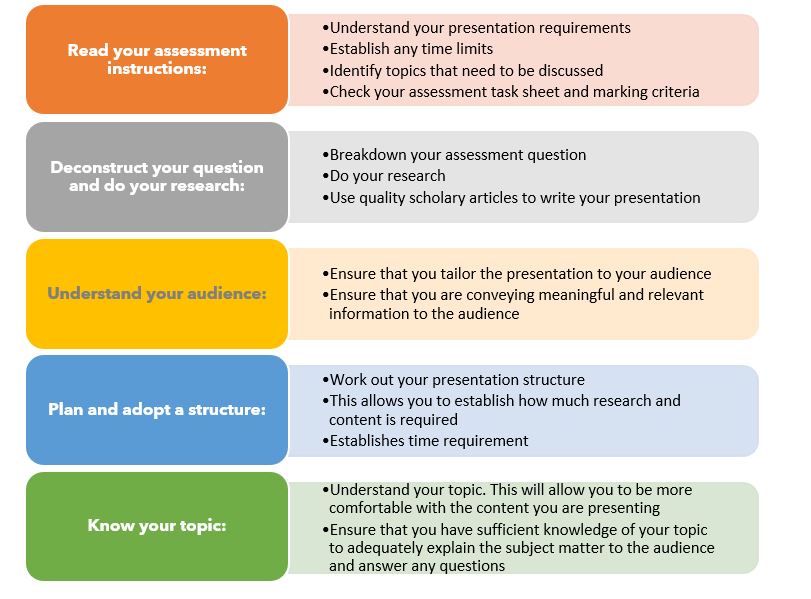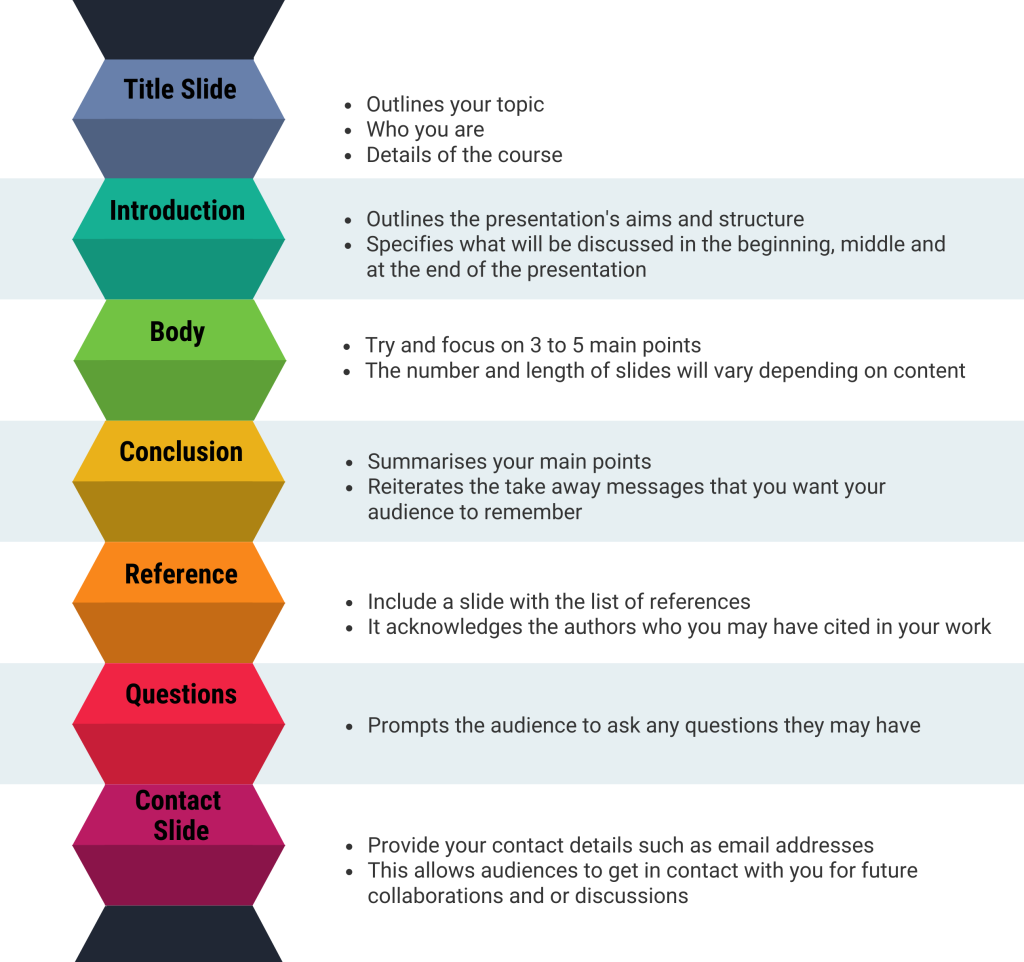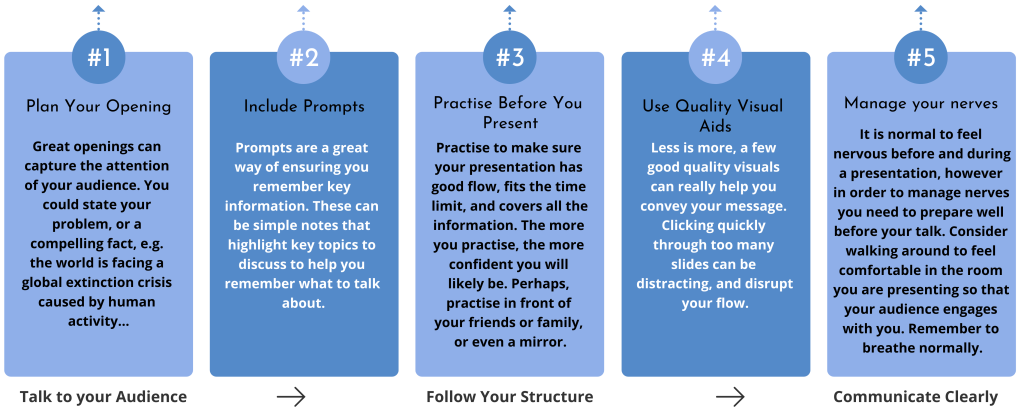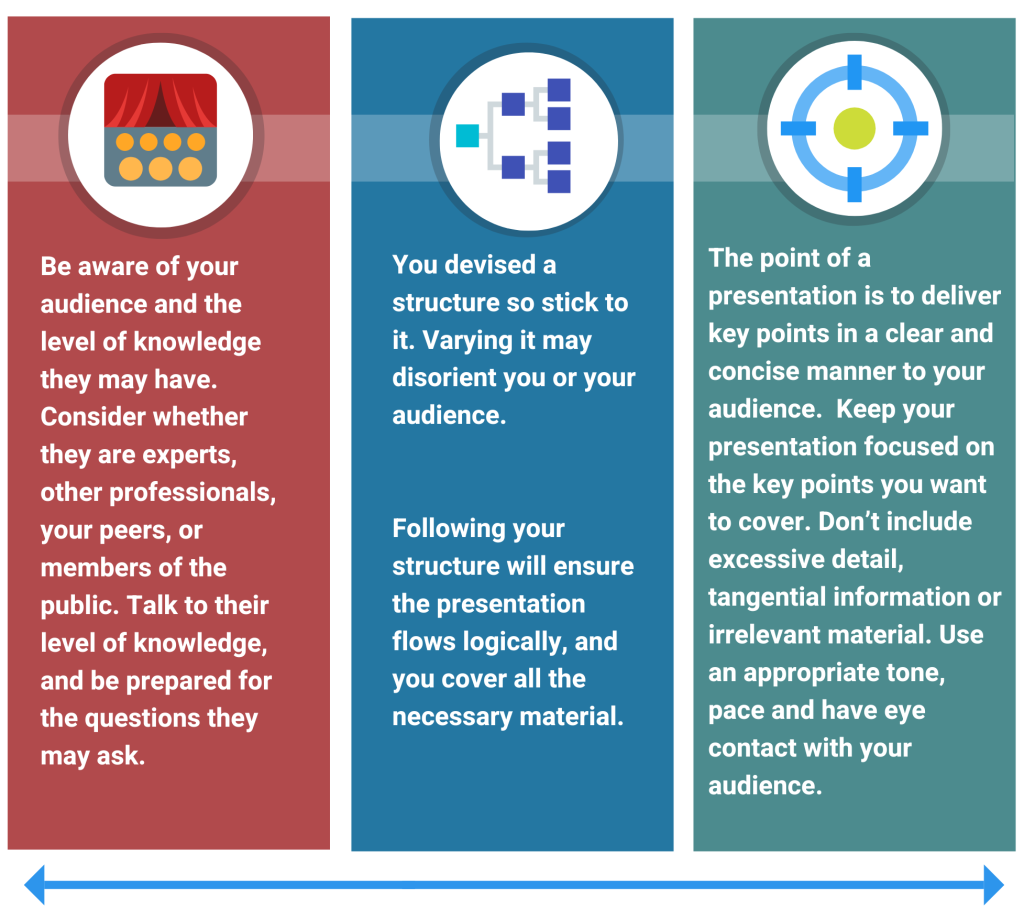Presentations
Rhian Morgan

Introduction
Presentations are a common form of assessment at university. At some point during your program, you will very likely be required to deliver information via a presentation. This chapter provides you with the foundational knowledge, skills, and tips to prepare and present your work effectively.
Types of Presentations
There are various types of presentations you may come across at university. Being aware of each type of presentation can be beneficial for you as a student. At university, most presentations will either be formal, informal, or group presentations.
- Formal presentations are instances where you are required to prepare in advance to deliver a talk. This can be for an assessment piece, interview, conference, or project. In a formal presentation, you are likely to use some form of visual tool to deliver the information.
- Informal presentations are occasions where you may be required to deliver an impromptu talk. This may occur in tutorials, meetings, or gatherings.
- Group presentations are normally formal and require you to work collaboratively with your peers in delivering information. Similar to formal presentations, group presentations require prior planning and practice. Group presentations are normally done for an assessment piece, projects, or conferences. Some visual tools may be used.
Regardless of the type of presentation you are asked to do, understanding the standard forms of presentations will assist with your preparation.
Preparation
Like other assessments or tasks, preparation is key to successfully delivering a presentation as it will help to ensure that you are heading in the right direction from the start. It will also likely increase your confidence in completing the presentation. Irrespective of the type of presentation, you can use the steps shown in Figure 73 for your preparation.

The steps shown in Figure 73 will essentially allow you to create tailored presentations which have directed content addressing a specific topic or task. This will allow you to engage your audience and deliver the message that you are trying to communicate effectively. Specific tips and tricks on how to present effectively are discussed later in this chapter.
Presentation Structure
Similar to written assignments, creating a structure is crucial to delivering your presentation. The benefits of having a structure are that your presentation will flow in a logical manner and your audience will be able to follow and understand the information you are delivering. Presentation structures may vary depending on whether you are presenting in a group, presenting informally, or presenting a poster. Nonetheless, using some form of structure will likely be beneficial to both you and your audience. When structuring a presentation, also consider the platform, technology and setting. For example, if you are presenting informally, you may not require the use of any form of technology or visual equipment. You may just rely on hand written notes. In contrast, if you are presenting in a more formal setting, you may prefer to use technology to assist you, such as PowerPoint. Figure 77 offers a sample you can use to create your structure. Be sure to check any task sheet given to you by your lecturer. They may have a particular structure they wish for you to use for a specific task.

Tips and Tricks
There are certain strategies you can use to help deliver a good presentation. Not every strategy is going to be applicable to all presentations and every individual. You will need to choose the strategies that work for you and meet the objectives of your presentation, relate to your audience, and importantly address the overall task. Delivering your work is one of the hardest aspects of a presentation, but it is achievable. Therefore, it is essential that you have the appropriate approach in your delivery. This includes prior planning, practice, and being confident.
The tips and tricks in this section will guide you in preparing and delivering effective presentations. Please note that some of these tips and tricks may be more relevant to oral than visual presentations.
Tip 1: Improve your delivery
Figure 75 presents five simple ways to lift the standard of your delivery.

Tip 2: Stay on track with your presentation
Figure 76 presents reminders about your audience, structure, and focus of your presentation to keep you on track.

Tip 3: Consider your voice and body
When giving an oral presentation, you should pay special attention to your voice and body. Voice is more than the sum of the noises you make as you speak. Pay attention to inflection, which is the change in pitch or loudness of your voice. You can deliberately use inflection to make a point, to get people’s attention, or to make it very obvious that what you are saying right now is important. You can also change the volume of your voice. Speak too softly, and people will think you are shy or unwilling to share your ideas; speak too loudly, and people will think you are shouting at them. Control your volume to fit the audience and the size of the venue. If you use these tips, you should do a good job of conveying your ideas to an audience.

Some people have a tendency to rush through their presentations because they are feeling nervous. This means they speed up their speech, and the audience has a difficult time following along. Take care to control the speed at which you give a presentation so that everyone can listen comfortably. You can achieve this by timing yourself when preparing and practising your talk. If you are exceeding the time limit, you may either be speaking too quickly, or have too much content to cover.
Also, to add to the comfort of the listeners, it is always nice to use a conversational tone in a presentation. This includes such components as stance, gesture, and eye contact—in other words, overall body language. How do you stand when you are giving a presentation? Do you move around and fidget? Do you look down at the ground or stare at your note cards? Are you chewing gum or sticking your hands in and out of your pockets nervously? Obviously, you don’t want to do any of these things. Make eye contact with your audience as often as possible. Stand in a comfortable manner, but don’t fidget. Use gestures sparingly to make certain points. Most importantly, try to be as comfortable as you can knowing that you have practised the presentation beforehand and you know your topic well. This will help to calm nerves.
Tip 4: Consider your attitude
Attitude is everything. Your enthusiasm for your presentation will prime the audience. If you are bored by your own words, the audience will be yawning. If you are enthused by what you have to offer, they will sit up in their seats and listen intently. Also, be interested in your audience. Let them know that you are excited to share your ideas with them because they are worth your effort.
Tip 5: Consider the visuals
You might also think about using technology to deliver your presentation. Perhaps you will deliver a slide presentation in addition to orally communicating your ideas to your audience. Keep in mind that the best presentations are those with minimal words or pictures on the screen, just enough to illustrate the information conveyed in your oral presentation. Do a search on lecture slides or presentation slides to find a myriad suggestions on how to create them effectively. You may also create videos to communicate what you found in your research.
Today, there are many different ways to take the information you found and create something memorable through which to share your knowledge. When you are making a presentation that includes a visual component, pay attention to three elements: design, method, and function. The design includes such elements as size, shape, colour, scale, and contrast. You have a vast array of options for designing a background or structuring the visual part of your presentation, whether online or offline.
Consider which method to use when visually presenting your ideas. Will it be better to show your ideas by drawing a picture, including a photograph, using clip art, or showing a video? Or will it be more powerful to depict your ideas through a range of colours or shapes? These decisions will alter the impact of your presentation. Will you present your ideas literally, as with a photograph, or in the abstract, as in some artistic rendition of an idea? For example, if you decide to introduce your ideas symbolically, a picture of a pond surrounded by tall trees may be the best way to present the concept of a calm person. Consider also the purpose of the visuals used in your presentation. Are you telling a story? Communicating a message? Creating movement for the audience to follow? Summarising an idea? Motivating people to agree with an idea? Supporting and confirming what you are telling your audience? Knowing the purpose of including the visual element of your presentation will make your decisions about design and method more meaningful and successful.
As mentioned previously, not every strategy is applicable to all presentations or to every individual. Choose the strategies that are relevant to you and focus on them.
Conclusion
Delivering a presentation may be daunting, especially if you are new to university. But as we have discussed in this chapter, there are several approaches you can use to help you prepare and deliver your presentation effectively. While each individual may have their own approach, preparing, planning, structuring and practising your presentation will go a long way to help you achieve success. Following the steps and considering the ideas in this chapter places you in a good position to deliver presentations effectively. The approaches are beneficial, but ensure you are adhering to any specific requirements included in the assignment task sheet. Following the task sheet closely and applying these presentation skills will increase your likelihood of academic success.
Key points
- Understand the type of presentation you are asked to deliver.
- Start preparing in advance and adopt a structure.
- Know your topic well and your audience.
- Try and practice different strategies, tools, and speaking approaches well before your presentation and ensure it is within the allocated time limit. Remember, practice, practice and practice!
- Be confident in yourself, your presentation skills, and follow the plan you have developed.

